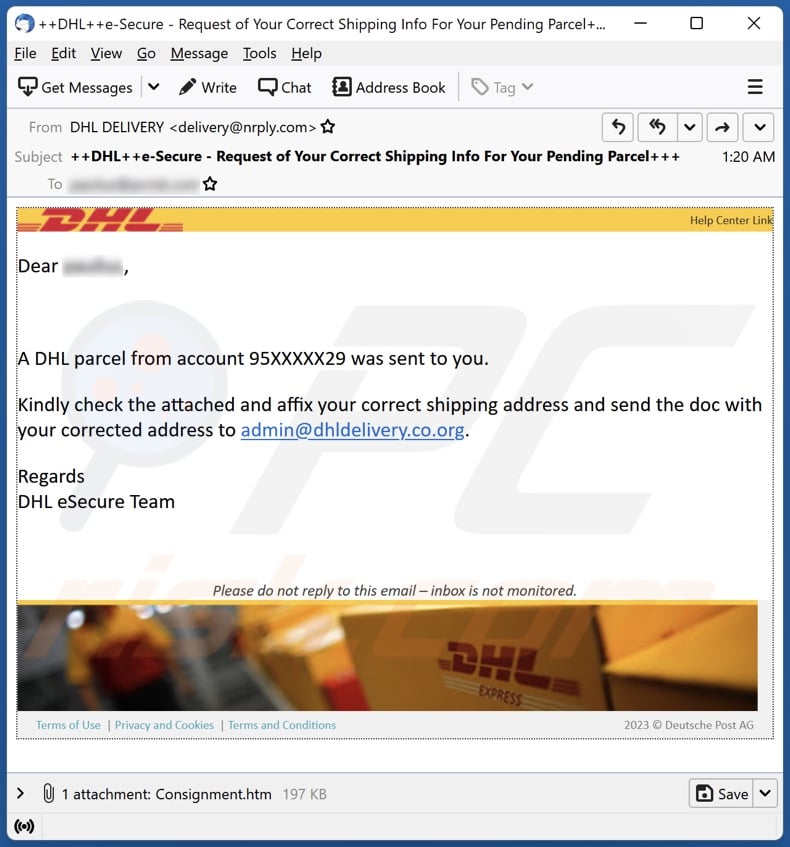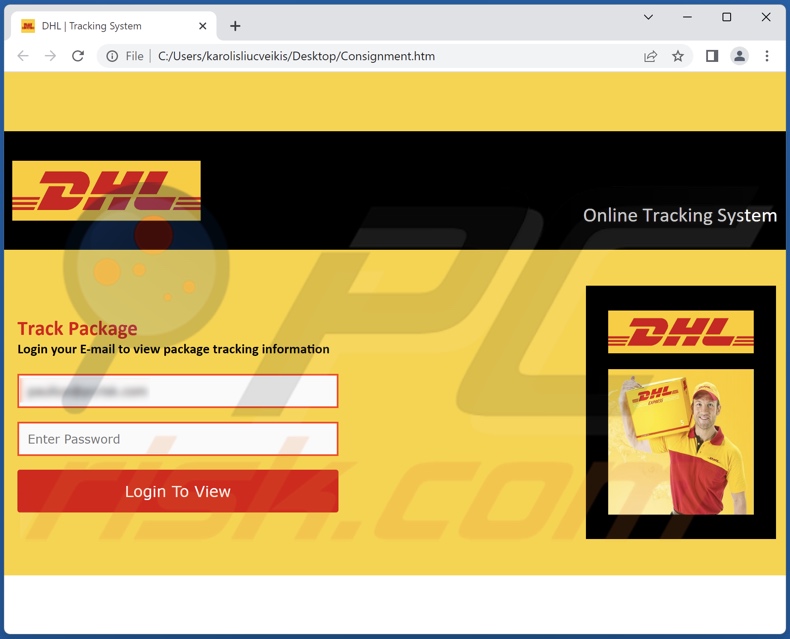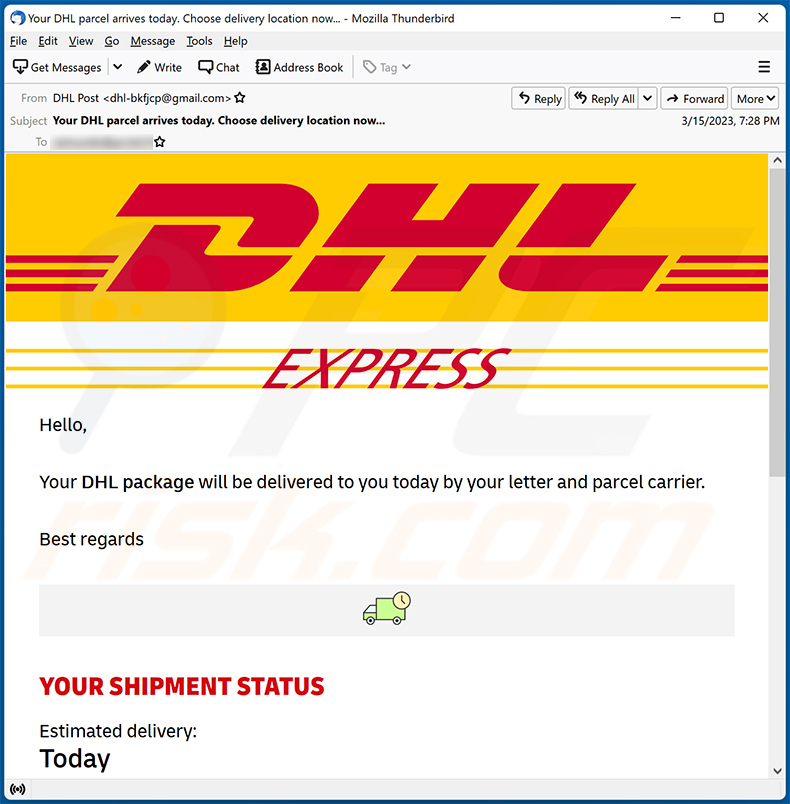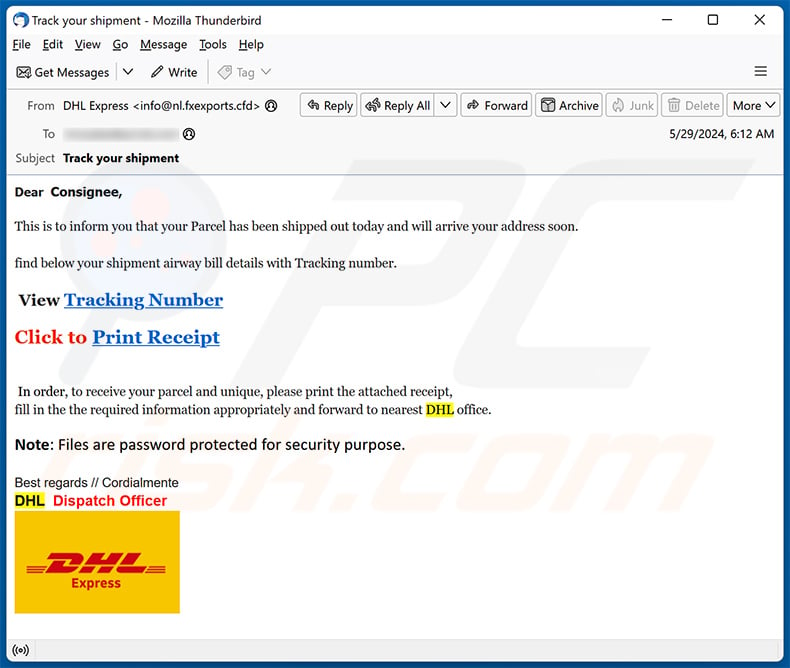Do not trust fake "DHL - A Parcel Was Sent To You" emails
Phishing/ScamAlso Known As: "DHL - A Parcel Was Sent To You" phishing email
Get free scan and check if your device is infected.
Remove it nowTo use full-featured product, you have to purchase a license for Combo Cleaner. Seven days free trial available. Combo Cleaner is owned and operated by RCS LT, the parent company of PCRisk.com.
What kind of email is "DHL - A Parcel Was Sent To You"?
After inspecting the "DHL - A Parcel Was Sent To You" email, we determined that it is fake. This spam letter is disguised as a notification from DHL regarding a shipment. This phishing mail aims to trick recipients into disclosing their email account log-in credentials. It must be stressed that this email is in no way associated with the actual DHL logistics company.

"DHL - A Parcel Was Sent To You" email scam overview
The email with the subject "DHLe-Secure - Request of Your Correct Shipping Info For Your Pending Parcel" (may vary) is presented as a notification from the DHL logistics company. The spam letter states that a parcel has been sent to the recipient and requests them to provide their correct shipping address. This information must be provided into the attached file.
As previously mentioned, this email and all its claims are fake, and this scam is in no way associated with the real DHL. When we opened the attached HTML file, it was presented as the "DHL Online Tracking System". The attachment instructed to sign in using an email account in order to access the package tracking data.
The log-in credentials entered into this phishing file (i.e., email address and corresponding password) will be recorded and sent to the scammers behind this spam campaign. In addition to stealing the exposed emails, the cyber criminals may be able to hijack the content registered through them.
To elaborate on how scammers can abuse the stolen content, they can use finance-related accounts (e.g., online banking, e-commerce, digital wallets, etc.) to make unauthorized transactions and online purchases.
Cyber criminals can also steal the identities of social account owners (e.g., emails, social networking, social media, messengers, etc.) and ask their contacts/friends for loans or donations, promote scams, and even proliferate malware by sharing malicious files/links.
To summarize, by trusting an email like "DHL - A Parcel Was Sent To You" – users can experience system infections, severe privacy issues, financial losses, and identity theft.
If you have already provided log-in credentials to scammers – we advise changing the passwords of all potentially exposed accounts and contacting their official support without delay.
| Name | "DHL - A Parcel Was Sent To You" phishing email |
| Threat Type | Phishing, Scam, Social Engineering, Fraud |
| Fake Claim | The recipient is requested to provide their address for a parcel sent by DHL. |
| Disguise | DHL |
| Attachment(s) | Consignment.htm (filename may vary) |
| Detection Names (attachment) | Google (Detected), Full List Of Detections (VirusTotal) |
| Symptoms | Unauthorized online purchases, changed online account passwords, identity theft, illegal access of the computer. |
| Distribution methods | Deceptive emails, rogue online pop-up ads, search engine poisoning techniques, misspelled domains. |
| Damage | Loss of sensitive private information, monetary loss, identity theft. |
| Malware Removal (Windows) |
To eliminate possible malware infections, scan your computer with legitimate antivirus software. Our security researchers recommend using Combo Cleaner. Download Combo CleanerTo use full-featured product, you have to purchase a license for Combo Cleaner. 7 days free trial available. Combo Cleaner is owned and operated by RCS LT, the parent company of PCRisk.com. |
Phishing spam campaign examples
We have analyzed thousands of spam emails; "Messages Not Delivered Due To Server Interruptions", "Product Availability Confirmation", "Measures To Strengthen Server Security", and "Incoming Mails Have Been Restricted" are merely a few examples of letters used for phishing log-in credentials.
This mail can target a wide variety of data. Furthermore, these letters facilitate various scams and even distribute trojans, ransomware, and other malware. These emails can be variously disguised, including as messages from legitimate companies, service providers, institutions, authorities, and other entities.
Due to how prevalent this mail can be, we highly recommend exercising caution with incoming emails, PMs/DMs, SMSes, and other messages.
How do spam campaigns infect computers?
Spam emails can contain malicious files as attachments or download links. Infectious files can be in various formats, e.g., documents (Microsoft Office, Microsoft OneNote, PDF, etc.), executables (.exe, .run, etc.), archives (RAR, ZIP, etc.), JavaScript, and so forth.
When a virulent file is executed, run, or otherwise opened – the malware download/installation is initiated. For example, Microsoft Office documents infect devices by executing malicious macro commands, while infectious Microsoft OneNote files need users to click on embedded content.
How to avoid installation of malware?
We advise approaching incoming emails, DMs/PMs, SMSes, and other messages with care. The attachments and links present in suspicious mail, as they can be malicious and cause infections. It is important to use post-2010 Microsoft Office versions since they have the "Protected View" mode that prevents automatic macro commands.
Note that malware is not proliferated exclusively via spam mail. Therefore, we advise downloading only from official and verified channels. Furthermore, all programs must be activated and updated using legitimate functions/tools, as illegal activation tools ("cracks") and third-party updaters can contain malware.
We also advise being vigilant while browsing since fake and dangerous online content usually appears ordinary and harmless.
We must emphasize the importance of having a dependable anti-virus installed and kept up-to-date. Security software must be used to run regular system scans and to remove detected threats. If you've already opened malicious attachments, we recommend running a scan with Combo Cleaner Antivirus for Windows to automatically eliminate infiltrated malware.
Text presented in the "DHL - A Parcel Was Sent To You" spam email letter:
Subject: DHLe-Secure - Request of Your Correct Shipping Info For Your Pending Parcel
DHL
Dear -,
A DHL parcel from account 95XXXXX29 was sent to you.
Kindly check the attached and affix your correct shipping address and send the doc with your corrected address to admin@dhldelivery.co.org.
Regards
DHL eSecure Team
Please do not reply to this email – inbox is not monitored.
Terms of Use | Privacy and Cookies | Terms and Conditions
2023 © Deutsche Post AG
Screenshot of the phishing attachment promoted by this spam campaign ("Consignment.htm" filename):

Yet another example of DHL delivery-themed spam email:

Text presented within:
Subject: Your DHL parcel arrives today. Choose delivery location now...
DHL EXPRESS
Important information about your package
Hello,
Your DHL package will be delivered to you today by your letter and parcel carrier.
Best regards
Your shipment status
Estimated delivery:
Today
Your shipment from:
MonsourceTracking number:
CPF 057 200 664 645Confirm delivery
Would you like to stop receiving information about your shipments in future?
Click here!Privacy policy
Imprint
Deutsche Post DHL Group2023 © DHL Paket GmbH. All rights reserved.
Another example of an email from "DHL - A Parcel Was Sent To You" spam campaign:

Text presented within:
Subject: Track your shipment
Dear Consignee,
This is to inform you that your Parcel has been shipped out today and will arrive your address soon.
find below your shipment airway bill details with Tracking number.
View Tracking Number
Click to Print Receipt
In order, to receive your parcel and unique, please print the attached receipt,
fill in the the required information appropriately and forward to nearest DHL office.Note: Files are password protected for security purpose.
Best regards // Cordialmente
DHL Dispatch Officer
Instant automatic malware removal:
Manual threat removal might be a lengthy and complicated process that requires advanced IT skills. Combo Cleaner is a professional automatic malware removal tool that is recommended to get rid of malware. Download it by clicking the button below:
DOWNLOAD Combo CleanerBy downloading any software listed on this website you agree to our Privacy Policy and Terms of Use. To use full-featured product, you have to purchase a license for Combo Cleaner. 7 days free trial available. Combo Cleaner is owned and operated by RCS LT, the parent company of PCRisk.com.
Quick menu:
- What is "DHL - A Parcel Was Sent To You" phishing email?
- Types of malicious emails.
- How to spot a malicious email?
- What to do if you fell for an email scam?
Types of malicious emails:
![]() Phishing Emails
Phishing Emails
Most commonly, cybercriminals use deceptive emails to trick Internet users into giving away their sensitive private information, for example, login information for various online services, email accounts, or online banking information.
Such attacks are called phishing. In a phishing attack, cybercriminals usually send an email message with some popular service logo (for example, Microsoft, DHL, Amazon, Netflix), create urgency (wrong shipping address, expired password, etc.), and place a link which they hope their potential victims will click on.
After clicking the link presented in such email message, victims are redirected to a fake website that looks identical or extremely similar to the original one. Victims are then asked to enter their password, credit card details, or some other information that gets stolen by cybercriminals.
![]() Emails with Malicious Attachments
Emails with Malicious Attachments
Another popular attack vector is email spam with malicious attachments that infect users' computers with malware. Malicious attachments usually carry trojans that are capable of stealing passwords, banking information, and other sensitive information.
In such attacks, cybercriminals' main goal is to trick their potential victims into opening an infected email attachment. To achieve this goal, email messages usually talk about recently received invoices, faxes, or voice messages.
If a potential victim falls for the lure and opens the attachment, their computers get infected, and cybercriminals can collect a lot of sensitive information.
While it's a more complicated method to steal personal information (spam filters and antivirus programs usually detect such attempts), if successful, cybercriminals can get a much wider array of data and can collect information for a long period of time.
![]() Sextortion Emails
Sextortion Emails
This is a type of phishing. In this case, users receive an email claiming that a cybercriminal could access the webcam of the potential victim and has a video recording of one's masturbation.
To get rid of the video, victims are asked to pay a ransom (usually using Bitcoin or another cryptocurrency). Nevertheless, all of these claims are false - users who receive such emails should ignore and delete them.
How to spot a malicious email?
While cyber criminals try to make their lure emails look trustworthy, here are some things that you should look for when trying to spot a phishing email:
- Check the sender's ("from") email address: Hover your mouse over the "from" address and check if it's legitimate. For example, if you received an email from Microsoft, be sure to check if the email address is @microsoft.com and not something suspicious like @m1crosoft.com, @microsfot.com, @account-security-noreply.com, etc.
- Check for generic greetings: If the greeting in the email is "Dear user", "Dear @youremail.com", "Dear valued customer", this should raise suspiciousness. Most commonly, companies call you by your name. Lack of this information could signal a phishing attempt.
- Check the links in the email: Hover your mouse over the link presented in the email, if the link that appears seems suspicious, don't click it. For example, if you received an email from Microsoft and the link in the email shows that it will go to firebasestorage.googleapis.com/v0... you shouldn't trust it. It's best not to click any links in the emails but to visit the company website that sent you the email in the first place.
- Don't blindly trust email attachments: Most commonly, legitimate companies will ask you to log in to their website and to view any documents there; if you received an email with an attachment, it's a good idea to scan it with an antivirus application. Infected email attachments are a common attack vector used by cybercriminals.
To minimise the risk of opening phishing and malicious emails we recommend using Combo Cleaner Antivirus for Windows.
Example of a spam email:

What to do if you fell for an email scam?
- If you clicked on a link in a phishing email and entered your password - be sure to change your password as soon as possible. Usually, cybercriminals collect stolen credentials and then sell them to other groups that use them for malicious purposes. If you change your password in a timely manner, there's a chance that criminals won't have enough time to do any damage.
- If you entered your credit card information - contact your bank as soon as possible and explain the situation. There's a good chance that you will need to cancel your compromised credit card and get a new one.
- If you see any signs of identity theft - you should immediately contact the Federal Trade Commission. This institution will collect information about your situation and create a personal recovery plan.
- If you opened a malicious attachment - your computer is probably infected, you should scan it with a reputable antivirus application. For this purpose, we recommend using Combo Cleaner Antivirus for Windows.
- Help other Internet users - report phishing emails to Anti-Phishing Working Group, FBI’s Internet Crime Complaint Center, National Fraud Information Center and U.S. Department of Justice.
Frequently Asked Questions (FAQ)
Why did I receive this email?
Spam emails are not personal. They are distributed in mass-scale operations – therefore, thousands of users receive identical messages.
I have provided my personal information when tricked by this spam email, what should I do?
If you have provided log-in credentials – change the passwords of all potentially exposed accounts and inform their official support without delay. And if you've disclosed other private data (e.g., ID card details, credit card numbers, etc.) – immediately contact the appropriate authorities.
I have read a spam email but didn't open the attachment, is my computer infected?
No, opening/reading an email is harmless. Devices are infected when malicious attachments or links are opened/clicked.
I have downloaded and opened a file attached to a spam email, is my computer infected?
If the opened file was an executable (.exe, .run, etc.) – most likely, yes – your device was infected. However, you might have avoided an infection if it was a document (.pdf, .doc, .xls, .one, etc.). These file formats may require additional user interaction (e.g., enabling macro commands, clicking on embedded files/links, etc.) to begin downloading/installing malware.
Will Combo Cleaner remove malware infections present in email attachments?
Yes, Combo Cleaner is designed to detect and eliminate threats. It is capable of removing practically all known malware infections. Keep in mind that performing a full system scan is crucial – since high-end malicious software usually hides deep within systems.
Share:

Tomas Meskauskas
Expert security researcher, professional malware analyst
I am passionate about computer security and technology. I have an experience of over 10 years working in various companies related to computer technical issue solving and Internet security. I have been working as an author and editor for pcrisk.com since 2010. Follow me on Twitter and LinkedIn to stay informed about the latest online security threats.
PCrisk security portal is brought by a company RCS LT.
Joined forces of security researchers help educate computer users about the latest online security threats. More information about the company RCS LT.
Our malware removal guides are free. However, if you want to support us you can send us a donation.
DonatePCrisk security portal is brought by a company RCS LT.
Joined forces of security researchers help educate computer users about the latest online security threats. More information about the company RCS LT.
Our malware removal guides are free. However, if you want to support us you can send us a donation.
Donate
▼ Show Discussion